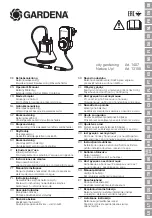
Auto Spot 150™
Controls and Functions
©
American DJ
®
- www.americandj.com - Auto Spot 150™ Instruction Manual Page 9
lamp. After replacing a lamp be sure the lamp is centered in the reflec-
tor. See page 20 for details on installing and optimizing replacement
lamps. Never operate this unit with the lamp exposed, this lamp emits
strong UV radiation.
9 Digital Display -
This display is detail the menu and operating func-
tions.
10. Menu Button -
This button is used to access the unit’s main
system menu and programming functions.
11. Down Button -
This button is used to scroll backwards when navi-
gating through the system menu.
12. Up Button -
This button is used to scroll forward when navigating
through the system menu.
13. Enter Button -
This button is used to select and confirm a function
when working in the system menu.
14. Microphone -
This microphone receives external low frequencies
to trigger the unit in Sound-Active and Master/Slave mode.
15. Audio Sensitivity Knob -
This knob adjust audio sensitivity of
the INTERNAL MICROPHONE (14). Turning the sensitivity knob in the
clockwise direction will increase the sensitivity to sound. Turning the
knob in the counter clockwise direction will decrease the fixture’s sen-
sitivity to sound.
16. IRC Controller Jack -
This jack is for use with the optional IRC
controller only. Do not attempt to connect an audio signal this jack,
this will damage the PC board and void your manufactures warranty!
17. Indicator LED’s -
The color coded LED’s will visually display the
unit’s current operating mode. A glowing LED will indicate an active
function.
©
American DJ
®
- www.americandj.com - Auto Spot 150™ Instruction Manual Page 10
Power Supply:
Before plugging your unit in, be sure the source volt-
age in your area matches the required voltage for your American DJ
®
Auto Spot 150.™ The American DJ
®
Auto Spot 150
™
is available in a
120v and 220v version. Because line voltage may vary from venue to
venue, you should be sure your unit voltage matches the wall outlet
voltage before attempting to operate you fixture. Also be sure to only
use the included I.E.C. power cable supplied with the unit, this cable
matched the voltage and current requirements of the unit.
DMX-512:
DMX is short for Digital Multiplex. This is a universal pro-
tocol used by most lighting and controller manufactures as a form of
communication between intelligent fixtures and controllers.
A DMX
controller sends DMX data instructions from the controller to the fix-
ture. DMX data is sent as serial data that travels from fixture to fixture
via the DATA “IN” and DATA “OUT” XLR terminals located on all DMX
fixtures (most controllers only have a DATA “OUT” terminal).
DMX Linking:
DMX is a language allowing all makes and models
of different manufactures to be linked together and operate from a
single controller, as long as all fixtures and the controller are DMX
compliant.
To ensure proper DMX data transmission, when using
several DMX fixtures try to use the shortest cable path possible. The
order in which fixtures are connected in a DMX line does not influence
the DMX addressing. For example; a fixture assigned a DMX address
of 1 may be placed anywhere in a DMX line, at the beginning, at the
end, or anywhere in the middle. Therefore, the first fixture controlled
by the controller could be the last fixture in the chain. When a fixture
is assigned a DMX address of 1, the DMX controller knows to send
DATA assigned to address 1 to that unit, no matter where it is located
in the DMX chain.
Data Cable (DMX Cable) Requirements (For DMX
and Master/Slave Operation):
The Auto Spot
150™ can be controlled via DMX-512 protocol.
The Auto Spot 150™ is a six channel DMX unit.
The DMX address is set electronically using the
controls on the side panel of the unit. Your unit and
your DMX controller require a standard 3-pin XLR
connector for data input and data output (Figure
Auto Spot 150™
Set Up
Figure 1






























